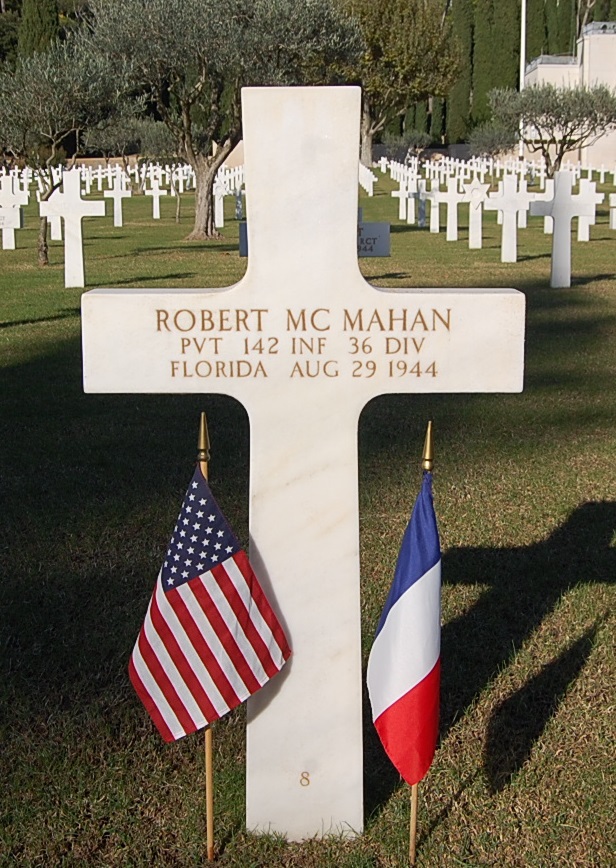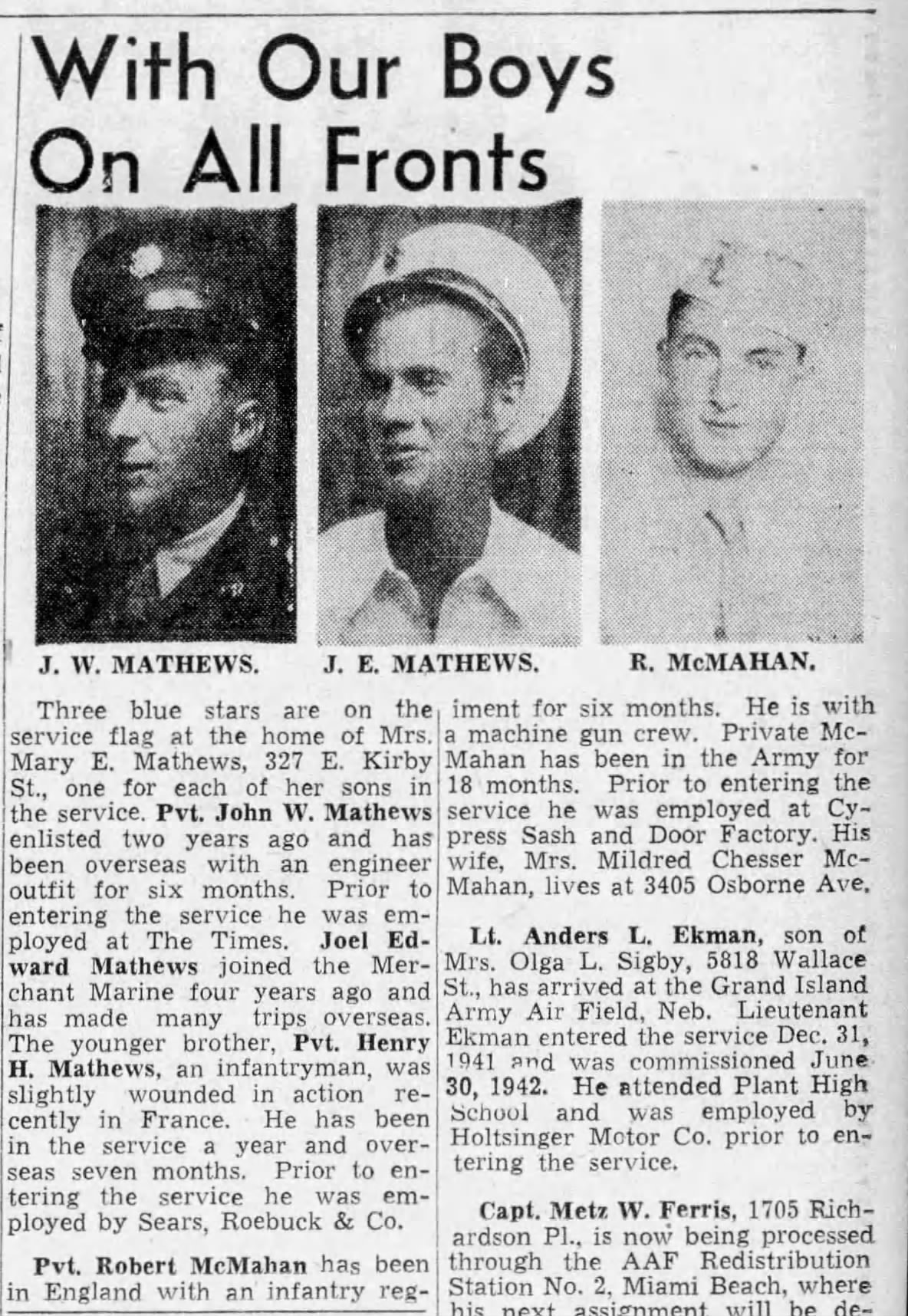|
Robert Mc MAHAN
| ||||||||||||||||||||||||||
|---|---|---|---|---|---|---|---|---|---|---|---|---|---|---|---|---|---|---|---|---|---|---|---|---|---|---|
|
Source : Projects.cah.ucf.edu (Ellen Marchese)
| ||||||||||||||||||||||||||
| NUMBER OF SERVICE | 34530352 | |||||||||||||||||||||||||
| AGE | 23 yo | |||||||||||||||||||||||||
| DATE OF BIRTH | 11 July 1921 | |||||||||||||||||||||||||
| ENLISTMENT STATE | FLORIDA | |||||||||||||||||||||||||
| FAMILY |
Spouse : Mildred | |||||||||||||||||||||||||
| RANK | Private | |||||||||||||||||||||||||
| FONCTION | Infantry Man | |||||||||||||||||||||||||
| JOB BEFORE ENLISTEMENT | Semiskilled cooperage occupations |  | ||||||||||||||||||||||||
| DATE of ENLISTEMENT | 13 November 1942 Camp BLANDING FLORIDA | |||||||||||||||||||||||||
| COMPANY | Company G | |||||||||||||||||||||||||
| REGIMENT | 142nd Infantry Regiment | |||||||||||||||||||||||||
| DIVISION | 36th Infantry Division | |||||||||||||||||||||||||
| DATE OF DEATH | 29 August 1944 |
Source : Andy | ||||||||||||||||||||||||
| STATUS | KIA | |||||||||||||||||||||||||
| PLACE OF DEATH | ||||||||||||||||||||||||||
| CEMETERY TEMPORARY |
CEMTERY TEMPORARY of Draguignan N°3519 | |||||||||||||||||||||||||
| CEMETERY | RHONE AMERICAN CEMETERY and MEMORIAL of Draguignan | |||||||||||||||||||||||||
| GRAVE |
| |||||||||||||||||||||||||
| DECORATION |
| |||||||||||||||||||||||||
| ||||||||||||||||||||||||||
| STORY | ||||||||||||||||||||||||||
|
Source : Projects.cah.ucf.edu
|
Early LifeRobert McMahan was born on July 11, 1921, in St. Clair County, AL.1 His parents, Albert and Dixie Bellah (née Day) McMahan, were born in Tennessee and moved between Tennessee, Alabama, and Georgia between 1910 and 1920, before settling down on a farm in St. Clair. Robert was one of eight children: James (1912), Cleo (1915), Dora May (1917), L.C. (1918), Georgia Lee (1923), Woodrow (1924), and Bobbie Lou (1927). In St. Clair, the McMahans lived next door to Dixie’s parents, Harvey and Mary Day, and her uncle, Ules Day. The two generations lived side-by-side, possibly working on the same farm. Like many in their community, the McMahans were general farmers, raising a wide variety of crops and livestock. Between 1930 and 1935, both generations moved to Harney, a rural area in Hillsborough County, FL. They became truck farmers, rather than subsistence farmers, meaning they grew specialty crops, such as watermelon, cabbages, tomatoes, or potatoes, and shipped them north, where seasonal changes made this produce unavailable. The two families lived in the same area but were no longer next door to each other. Robert went to live with his grandparents and great uncle, likely because they needed an extra hand on their farm. In 1935, Harvey and Mary Day were in their seventies and Ules Day in his late sixties. Robert, a teenager, might have been the perfect age to help them. He left school after third grade, but as part of a farming family, he would have had knowledge and some understanding of what was expected of him as a farm hand. In 1938, Robert’s mother Dixie passed away. She was only forty-six. By 1942, Robert left the agriculture industry and found employment at the Cypress Sash and Door Factory in Tampa, FL. He married Mildred Lee Chesser on June 1, 1942. The daughter of Daniel Ira and Emma Elizabeth Chesser, Mildred grew up in Tampa, where her father worked as a crane operator at the Tampa shipyards. At the time of her marriage, she was fifteen, and Robert was twenty-one. | |||||||||||||||||||||||||
Military ServiceLess than six months after his wedding, Robert was drafted and reported to Camp Blanding, FL, for training on November 13, 1942.12 There, he became a private in Company G, 142nd Infantry Regiment, 36th Infantry Division.13 Robert trained for about a year before his division shipped out and landed in North Africa on April 13, 1943. From April to September, the 36th Division prepared for the Allied invasion of Italy, or Operation Avalanche, by training at the cities of Anzew, Algeria, and Rabat, Morocco.14 Allied troops successfully took the island of Sicily in July 1943, which triggered the downfall of Italy’s fascist leader, Mussolini. The new Italian government surrendered to the Allied forces on September 8, 1943, but the German leaders ordered their troops who were already posted in Italy to continue the fight. The next day, Allied forces, including Robert’s division, landed at the Gulf of Salerno in southern Italy. There, they repulsed heavy counterattacks by the German Army with the support of naval ships and paratroopers, and pushed inland, securing territory across the peninsula. During Operation Avalanche, the 36th Division suffered heavy losses and the men who remained became part of reserves for the 5th Army. They got time to rest, resupply and retrain from March to May 1944. While most of the division remained in Italy during this rest period, its commanders sent a select group of soldiers, including Robert, to England for further training. Robert was part of a machine gun crew, as described in this article in The Tampa Times. He remained in England from March to August 1944. Meanwhile, while Robert was in England, the 36th Division redeployed in late May to help the Allied forces break through strong German resistance at the beaches of Anzio and take the city of Rome on June 5, 1944. While the capture of the capital was a significant feat for the Allied troops, the battle for Italy was not over, as the German troops retreated to a fortified line in northern Italy in order to continue the fight. Allied attention, however, shifted to a new front, that of occupied France. After a short rest period, the US Army sent the 36th Division to the southern French coast to participate in Operation Dragoon. The Allied forces planned to liberate occupied France from two fronts: the northern and southern coast. On June 6, 1944, they launched the D-day landings at the beaches of Normandy in northern France, and a month later they launched a second landing along the southern coast, called Operation Dragoon. On August 15, 1944, Robert and the 36th Division landed at a beach half-way between St. Tropez and Cannes and took the town of Saint Raphael before pushing inland with the rest of the Allied troops. In response to the invasion, the Germans began to withdraw their troops in southern France to the Vosges mountains near the Franco-German border. The Allied command wanted to block their retreat and sent the 36th Division northward as quickly as possible to the city of Montelimar, a key city on the Germans’ escape route up Highway 7N. The battle at Montelimar raged from August 23 to the 30th, as the US forces struggled to stop an entire army convoy. On August 29, as the fighting died down, the military command sent Robert’s 142nd Regiment to seize Livron, a small town north of Montelimar that sat on Highway 7N. During this engagement, enemy fire struck Robert in the leg, and he died of his wounds. LegacyPvt. Robert McMahan died in battle at the age of twenty-three, for which he received a Purple Heart. He is buried in the Rhone American Cemetery in France. He left behind his extended family and his wife, Mildred. The couple had no children together. Widowed at seventeen, Mildred remarried several times throughout her life and passed away in 2009. She is buried at the Fort McCoy Cemetery in Marion County, FL. In 1995, the local Federation of the French Forces of the Interior, dedicated to preserving the memory of the French Resistance, created a monument in Mirmande, France, between the cities of Montelimar and Livron. The Miramande monument honors the local Resistance fighters who died for France and the 221 American soldiers, including Robert, who died in combat in the area between August 20 and 30, 1944. Like Robert, most of these American soldiers died blocking the German retreat at Montelimar. Although some German battalions got through the blockade, by the end of the battle the US forces almost completely destroyed the German Nineteenth Army, which not only contributed to the liberation of southern France, but also severely weakened the German forces for the battles to come. | ||||||||||||||||||||||||||
| | ||||||||||||||||||||||||||
Activated/Activé |
Normandy/Normandie |
| 25 Nov 1940 | Days of Combat/Jour de Combat 400 |
| Casualties/Victimes 19 466 | |
Entered Combat/Entré au combat |
|
| 9 Sep 1943 Salerno | |
|
Commanding Generals/Commandants généraux Maj. Gen. Claude V. Birkhead (Nov 40 - Sep 41) |
Campaigns/CampagnesNaples-Foggia (9 Sep 43 - 21 Jan 44) Southern France (15 Aug 44 - 14 Sep 44) |
PLAN DE ROUTE DE LA CAMPAGNE - CAMPAIGN ROUTE MAP |
|
|
 |
|
DIVISION CHRONICLEThe 36th Infantry Division landed in North Africa, 13 April 1943, and trained at Arzew and Rabat. It first saw action, 9 September 1943, when it landed at Paestum on the Gulf of Salerno. The waiting enemy launched counterattacks, but the 36th advanced slowly, securing the area from Agropoli to Altavilla. After a brief rest the 36th returned to combat, 15 November. It captured Mount Maggiore, Mount Lungo, and the village of San Pietro despite strong enemy positions and severe winter weather. This grueling campaign was marked by futile attempts to establish a secure bridgehead across the Rapido River, 1 January to 8 February 1944. After assisting the 34th Division in the attack on Cassino and fighting defensively along the Rapido River, the 36th withdrew, 12 March 1944, for rest and rehabilitation. On 25 May, the Division landed at Anzio, drove north to capture Velletri, 1 June, and entered Rome on the 5th. Pushing up from Rome, the 36th encountered sharp resistance at Magliano, but reached Piombino, 26 June, before moving back to Paestum for rest and rehabilitation. On 15 August, the Division made another assault landing against light opposition in the RaphaelFrejus area of Southern France. A lightning dash opened the Rhone River Valley. Montelimar fell, 28 August, and large Nazi units were trapped. The 36th advanced to the Moselle River at Remiremont and the foothills of the Vosges. In a grinding offensive, the Division crossed the Meurthe River, breached the Ste. Marie Pass and burst into the Alsatian Plains. The enemy counterattacked, 13 December, and the 36th held in the Colmar Pocket. On the 20th the Division resumed the attack, advancing northward along the Rhine River to Mannheim meeting heavy resistance at Haguenau, Oberhofen, and Wissembourg. The 36th moved to the Danube, 22 April 1945, and attacked the "National Redoubt" at Kunzelsau on the 30th in its final action. |
CHRONIQUE DE DIVISIONThe 36th Infantry Division landed in North Africa, 13 April 1943, and trained at Arzew and Rabat. It first saw action, 9 September 1943, when it landed at Paestum on the Gulf of Salerno. The waiting enemy launched counterattacks, but the 36th advanced slowly, securing the area from Agropoli to Altavilla. After a brief rest the 36th returned to combat, 15 November. It captured Mount Maggiore, Mount Lungo, and the village of San Pietro despite strong enemy positions and severe winter weather. This grueling campaign was marked by futile attempts to establish a secure bridgehead across the Rapido River, 1 January to 8 February 1944. After assisting the 34th Division in the attack on Cassino and fighting defensively along the Rapido River, the 36th withdrew, 12 March 1944 , for rest and rehabilitation. On 25 May, the Division landed at Anzio, drove north to capture Velletri, 1 June, and entered Rome on the 5th. Pushing up from Rome, the 36th encountered sharp resistance at Magliano, but reached Piombino, 26 June, before moving back to Paestum for rest and rehabilitation. On 15 August, the Division made another assault landing against light opposition in the RaphaelFrejus area of Southern France. A lightning dash opened the Rhone River Valley. Montelimar fell, 28 August, and large Nazi units were trapped. The 36th advanced to the Moselle River at Remiremont and the foothills of the Vosges. In a grinding offensive, the Division crossed the Meurthe River, breached the Ste. Marie Pass and burst into the Alsatian Plains. The enemy counterattacked, 13 December, and the 36th held in the Colmar Pocket. On the 20th the Division resumed the attack, advancing northward along the Rhine River to Mannheim meeting heavy resistance at Haguenau, Oberhofen, and Wissembourg. The 36th moved to the Danube, 22 April 1945, and attacked the "National Redoubt" at Kunzelsau on the 30th in its final action.
|
| SOURCE INFORMATION & PHOTO | Armydivs.squarespace.com |
|---|
| SOURCE INFORMATION & SOURCE PHOTO | Findagrave.com - Abmc.gov - Aad.archives.gov - Projects.cah.ucf.edu |
|---|---|
| PROGRAMMER | Eric, Henri, Garrett, Clive, Frédéric & Renaud |




























